CANINE HUNTER SAFETY
Program Goals
- To help every hunter understand the value of hunting with a trained dog
- To help hunters train dogs to be safe hunting companions
- To provide certification for dogs who can prove themselves to be safe hunting companions
Introduction
Hunters are willing to work with their dogs in the basic skills necessary to locate and retrieve game.
For each type of hunting and hunting dog, there are testing programs sponsored by national organizations to provide an "outline" or standard that can give owners goals.
To date, however, no one has addressed the issue of training a dog to be safe to hunt with. We have safety training programs for hunters, but have neglected our best hunting buddies-our dogs.
Each year, many dogs are shot as a result of poor control, unruliness, and simple ignorance of hunting conditions. We do not know how many hunters are injured by dogs exhibiting unskilled behaviors on hunting trips.
The Canine Hunter Safety Certification Program was designed to offer the hunter an opportunity to acquaint his dog with the basic scenarios involved in typical hunting situations, and a way to train the dog to deal with each of these situations so that these new behaviors may be applied in the field.
This certification is non-competitive, it is simply a basic safety course that any dog can master with some very basic training and repetition.
Skills Required for Certification
All skills must be accomplished while the handler is carrying an open shotgun. The handler must exhibit safe gun handling practices during the entire testing process, or will be immediately disqualified.
1. Dog must be able to easily jump into a kennel or crate in a vehicle, and jump out.
2. Dog must walk easily on a leash along a path.
3. Dog must be able to sit while a gate is opened, walk through on command, and sit on the other side while the gate is refastened.
4. Dog must be able to walk over a footbridge, of logs or planks, simulating a bridge over a gully or stream.
5. Dog must be able to move into a hunting blind, and sit quietly, while calls and shots are fired outside the blind.
6. Dog must be able to walk in and among decoys on the ground without undue disturbance.
7. Dog must be able to move to an area while the hunter sits on a stool, and when a stranger approaches, wait quietly while the stranger and owner converse. The dog should not growl, attack, or hide from the stranger.
8. The dog must be able to walk onto a dock, and on command, jump into a boat and sit quietly while decoys are tossed out of the boat. The dog must then be able to return to the dock from the boat.
9. The dog must be able to jump up on a tree stand, and sit quietly while someone calls and shoots.
10. The dog must be able to sit quietly while tied while the handler leaves for 3 minutes.
All tests are to be performed on leash, and the dog may be clipped or tied in each area of testing. The dog should be able to complete all the stations while acting calmly and quietly. A dog that repeatedly barks, whines or howls shall be disqualified. A dog that pulls, jumps, or lunges on lead shall be disqualified. The goal is to have a quiet, mannerly dog that is an agreeable and SAFE hunting partner.
Training for the Canine Hunter Safety Test
1. The dog must be able to easily jump into a crate or kennel, and jump out.
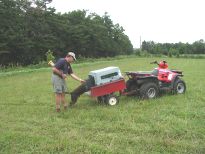 Hopefully, your dog was crate trained as a pup, and is used to jumping into a crate. If not, now is the time to start. A crated dog is much safer in any moving vehicle, and will learn to lie down quietly and rest on the trip to and from the day’s hunt.
To teach your dog to enter a crate, you must have a crate large enough for the dog to enter, standing, and comfortably turn around in. If a 2- piece crate, start by teaching the dog on lead to enter the bottom half of the crate while it is sitting on the ground or floor, and reward him with a cookie or warm praise. Once the dog will eagerly enter the crate, and sit in the bottom half quietly, assemble the crate and teach him to enter it, again giving lavish praise. Often, having the dog facing the crate, and tossing a cookie into the crate will encourage the dog to enter, and also help in keeping him in the crate for a few seconds while he eats his treat. Now, close the crate and turn away. If the dog whines or makes noise, give a verbal correction, such a "Hush" or "Quiet" and move away. The dog should learn to rest quietly in the crate until you return. If you let the dog out while he is being noisy, you will only reward him for that undesirable behavior.
Hopefully, your dog was crate trained as a pup, and is used to jumping into a crate. If not, now is the time to start. A crated dog is much safer in any moving vehicle, and will learn to lie down quietly and rest on the trip to and from the day’s hunt.
To teach your dog to enter a crate, you must have a crate large enough for the dog to enter, standing, and comfortably turn around in. If a 2- piece crate, start by teaching the dog on lead to enter the bottom half of the crate while it is sitting on the ground or floor, and reward him with a cookie or warm praise. Once the dog will eagerly enter the crate, and sit in the bottom half quietly, assemble the crate and teach him to enter it, again giving lavish praise. Often, having the dog facing the crate, and tossing a cookie into the crate will encourage the dog to enter, and also help in keeping him in the crate for a few seconds while he eats his treat. Now, close the crate and turn away. If the dog whines or makes noise, give a verbal correction, such a "Hush" or "Quiet" and move away. The dog should learn to rest quietly in the crate until you return. If you let the dog out while he is being noisy, you will only reward him for that undesirable behavior.
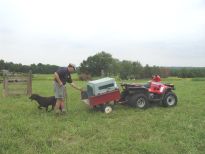 Once the dog will willingly enter the crate and remain in it quietly, place the crate on a low platform or other elevated surface. Be sure the crate is resting securely, not wobbly, or the dog will become wary of jumping in. Repeat the training process until the dog will easily jump up into the crate while it sits in the back of your vehicle.
Work with your dog, teaching him to wait patiently when you open the door of the crate to have his leash attached, so when he hops out of the crate and onto the ground, you have him under control.
You now have mastered the first step of the canine hunter safety course.
Once the dog will willingly enter the crate and remain in it quietly, place the crate on a low platform or other elevated surface. Be sure the crate is resting securely, not wobbly, or the dog will become wary of jumping in. Repeat the training process until the dog will easily jump up into the crate while it sits in the back of your vehicle.
Work with your dog, teaching him to wait patiently when you open the door of the crate to have his leash attached, so when he hops out of the crate and onto the ground, you have him under control.
You now have mastered the first step of the canine hunter safety course.
2. Dog must walk easily on a leash along a path.
If you have not taught your dog basic obedience, now is the time to enroll in a local obedience course or to get busy teaching him yourself. The big difference in working with your dog in the backyard and in the hunting field is DISTRACTION.
The way to teach your dog to be obedient in the face of distraction is to introduce him to it gradually in situations where you have control over him. Your dog MUST understand the basic commands, sit, heel, down, and stay, so that he responds immediately each and every time you give him one of these commands. Once your dog responds reliably without distraction, ask a family member or frind to come and walk around and talk to you while you are training your dog. Your dog still obey each and every command, and you must use the same method for getting him to comply that you did when you initially taught him to obey. Escalate the level of distraction every few sessions, such as having your friend tossing a ball while talking to you, bringing a dog on a leash to work in the yard while you are practicing, and eventually moving to field area and doing some shooting and field work while your dog must still be quiet and obedient. After all, this is the challenge that your dog will face in a normal hunting situation.
 3. Dog must be able to sit while a gate is opened, walk through on command, and sit on the other side while the gate is fastened.
3. Dog must be able to sit while a gate is opened, walk through on command, and sit on the other side while the gate is fastened.
If your dog has mastered #2, this should be easy for you. Be sure to practice with different gates, as some are noisy, and the dog may find the noise or sight of the gate unsettling on first exposure. This is an important skill, as we are often hunting on others’ land, and keeping gates closed is a simple but essential courtesy if you plan to hunt here again.
4. Dog must be able to walk over a footbridge, of logs or planks, simulating a bridge over a gully or stream.
 It is best to introduce your dog to this skill on a wooden or plank bridge, or dock, if one is available. The dog must learn to be comfortable walking on an elevated surface, through which he can see the ground (far) below. Teaching a dog to climb up and down open stairs, such as those that lead into a basement, or up onto a deck, will also be helpful. When your dog can successfully navigate decks and stairways, it is time to introduce him to a rounded surface such as a telephone pole or large fallen log. It is best for you to walk beside the pole initially, holding him on a short lead and help to support or “spot” his body with the other hand until he learns to keep his balance. As he practices, he will enjoy this, and you will be amazed at how agile and surefooted he will become. You may want to contact a local agility instructor to help you with this. Agility courses have an elevated plank walk that you may be able to use, and the instructor can help show you how to introduce your dog to this safely.
It is best to introduce your dog to this skill on a wooden or plank bridge, or dock, if one is available. The dog must learn to be comfortable walking on an elevated surface, through which he can see the ground (far) below. Teaching a dog to climb up and down open stairs, such as those that lead into a basement, or up onto a deck, will also be helpful. When your dog can successfully navigate decks and stairways, it is time to introduce him to a rounded surface such as a telephone pole or large fallen log. It is best for you to walk beside the pole initially, holding him on a short lead and help to support or “spot” his body with the other hand until he learns to keep his balance. As he practices, he will enjoy this, and you will be amazed at how agile and surefooted he will become. You may want to contact a local agility instructor to help you with this. Agility courses have an elevated plank walk that you may be able to use, and the instructor can help show you how to introduce your dog to this safely.
5. Dog must be able to move into a hunting blind, and sit quietly, while calls and shots are fired outside the blind.
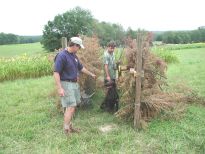 This skill should be taught initially with you sitting on a stool in plain view of the shots and calls. The dog can see what is happening, and become accustomed to the noise, and learn that not all calls and shots are associated with activity. Have a friend blow a call, and reinforce the sit command with your dog. Do this repeatedly until the dog understands he should sit quietly during calling. It may be good to use different kinds of calls when teaching this. Then, have your firend shoot a cap or blank pistol, again reinforcing the sit command. When your dog can sit quietly in full view of this activity, it is time to start moving him out of sight, so he just hears these noises. He will initially want to go and see where the noises are coming from, but persist in requiring him to sit quietly, and he will eventually understand.
This skill should be taught initially with you sitting on a stool in plain view of the shots and calls. The dog can see what is happening, and become accustomed to the noise, and learn that not all calls and shots are associated with activity. Have a friend blow a call, and reinforce the sit command with your dog. Do this repeatedly until the dog understands he should sit quietly during calling. It may be good to use different kinds of calls when teaching this. Then, have your firend shoot a cap or blank pistol, again reinforcing the sit command. When your dog can sit quietly in full view of this activity, it is time to start moving him out of sight, so he just hears these noises. He will initially want to go and see where the noises are coming from, but persist in requiring him to sit quietly, and he will eventually understand.
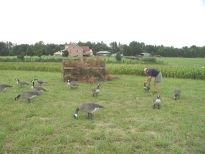 6. Dog must be able to walk in and among decoys on the ground without undue disturbance.
6. Dog must be able to walk in and among decoys on the ground without undue disturbance.
Set some decoys on the ground. If you don’t have any decoys, empty soda bottles, bleach or fabric softener bottles painted to look like decoys will do. Allow your dog to sniff at the decoys, but not mouth or pick them up. Work your dog on a leash around and near the decoys, and as he learns to ignore them, while obeying basic obedience commands, eventually start heeling him through the decoys. He should be able to heel, turn, sit, down, and stay among the decoys, paying no attention to them.
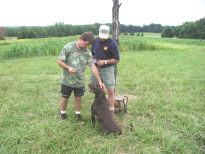 7. Dog must be able to move to an area while the hunter sits on a stool, and when a stranger approaches, wait quietly while the stranger and owner converse. The dog should not growl, attack, or hide from the stranger.
7. Dog must be able to move to an area while the hunter sits on a stool, and when a stranger approaches, wait quietly while the stranger and owner converse. The dog should not growl, attack, or hide from the stranger.
This skill is designed to simulate a visit from a landowner or game warden while hunting. The dog may be tied or held, but should neither jump on or shy away from the friendly stranger. Any barking or uncontrolled aggressive behavior toward the visitor will be cause for disqualification. The dog must sit quietly while the handler shows a hunting license or other permission to the visitor. The dog should not interfere with this exchange.
8. The dog must be able to walk onto a dock, and on command, jump into a boat and sit quietly while decoys are tossed out of the boat. The dog must then be able to return to the dock from the boat.
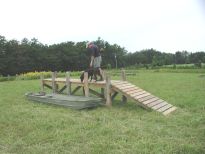 Much of the training for this will have occurred while training for the log bridge. The dog should now be used to walking on a dock or plank bridge.
To teach your dog to jump into a boat, initially have the dog learn to kennel into a boat that is sitting on the ground. Once the dog will readily jump into the boat, and sit and wait quietly in the boat, and jump out when commanded, it is time to either slide half the boat into the water or up onto some old tires to simulate the unsteady nature of a boat in water. Again teach the dog to enter the boat readily and quietly, and remain sitting in the boat. Eventually
Much of the training for this will have occurred while training for the log bridge. The dog should now be used to walking on a dock or plank bridge.
To teach your dog to jump into a boat, initially have the dog learn to kennel into a boat that is sitting on the ground. Once the dog will readily jump into the boat, and sit and wait quietly in the boat, and jump out when commanded, it is time to either slide half the boat into the water or up onto some old tires to simulate the unsteady nature of a boat in water. Again teach the dog to enter the boat readily and quietly, and remain sitting in the boat. Eventually 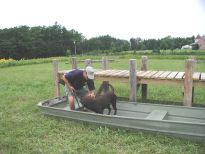 the dog should be able to enter a boat in the water, and sit quietly while you paddle or motor about in the water, then when returning back to shore, leave the boat on command. It is acceptable to tie the dog in the boat.
To complete the training for this exercise, your dog will need to learn to wait on the dock while you jump in the boat, or in the boat while you jump in. Either is acceptable for qualifying on this skill.
the dog should be able to enter a boat in the water, and sit quietly while you paddle or motor about in the water, then when returning back to shore, leave the boat on command. It is acceptable to tie the dog in the boat.
To complete the training for this exercise, your dog will need to learn to wait on the dock while you jump in the boat, or in the boat while you jump in. Either is acceptable for qualifying on this skill.
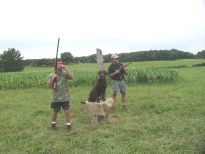 9. The dog must be able to jump up on a tree stand, and sit quietly while someone calls and shoots.
9. The dog must be able to jump up on a tree stand, and sit quietly while someone calls and shoots.
If your dog has mastered the skills necessary to reach this step, you will have little training left to complete this skill. Your dog may be tied to the tree stand to accomplish this, as you must step away from the dog and shoulder your gun while your "hunting partner" calls and shoots.
10. The dog must be able to sit quietly while tied while the handler leaves for 3 minutes.
If you have taught your dog basic obedience, he should have some understanding of the stay command. To work on this skill, you may want to tie your dog to a post or car bumper, give him the stay command, and walk a few feet away. If your dog starts to follow you, return to him, sit him down again, and repeat the command. If he can sit 5-10 seconds quietly, return to him and praise him. Very gradually, extend the amount of time you leave your dog on stay, and the distance away from him, eventually leaving him tied while you go out of sight.
Your dog must sit or down quietly, without whining, barking, or tugging at the leash.
SAMPLE SCORE SHEET
Canine Safe Hunter Certification
Dog’s Name________________________________________Date_____________
Owner’s Name_________________________________Phone_________________
Breed_______________________Sex _________N?______Age________________
Examiners:_1)___________________________2)__________________________


Phyllis Giroux, DVM
Deep Run Farm
13727 Blackwells Mill Road
Goldvein, VA 22720
540-752-4888
f. 540-752-4775
www.DeepRunRetrievers.com
© 2011, Deep Run Farm, all rights reserved
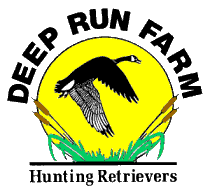

 Hopefully, your dog was crate trained as a pup, and is used to jumping into a crate. If not, now is the time to start. A crated dog is much safer in any moving vehicle, and will learn to lie down quietly and rest on the trip to and from the day’s hunt.
To teach your dog to enter a crate, you must have a crate large enough for the dog to enter, standing, and comfortably turn around in. If a 2- piece crate, start by teaching the dog on lead to enter the bottom half of the crate while it is sitting on the ground or floor, and reward him with a cookie or warm praise. Once the dog will eagerly enter the crate, and sit in the bottom half quietly, assemble the crate and teach him to enter it, again giving lavish praise. Often, having the dog facing the crate, and tossing a cookie into the crate will encourage the dog to enter, and also help in keeping him in the crate for a few seconds while he eats his treat. Now, close the crate and turn away. If the dog whines or makes noise, give a verbal correction, such a "Hush" or "Quiet" and move away. The dog should learn to rest quietly in the crate until you return. If you let the dog out while he is being noisy, you will only reward him for that undesirable behavior.
Hopefully, your dog was crate trained as a pup, and is used to jumping into a crate. If not, now is the time to start. A crated dog is much safer in any moving vehicle, and will learn to lie down quietly and rest on the trip to and from the day’s hunt.
To teach your dog to enter a crate, you must have a crate large enough for the dog to enter, standing, and comfortably turn around in. If a 2- piece crate, start by teaching the dog on lead to enter the bottom half of the crate while it is sitting on the ground or floor, and reward him with a cookie or warm praise. Once the dog will eagerly enter the crate, and sit in the bottom half quietly, assemble the crate and teach him to enter it, again giving lavish praise. Often, having the dog facing the crate, and tossing a cookie into the crate will encourage the dog to enter, and also help in keeping him in the crate for a few seconds while he eats his treat. Now, close the crate and turn away. If the dog whines or makes noise, give a verbal correction, such a "Hush" or "Quiet" and move away. The dog should learn to rest quietly in the crate until you return. If you let the dog out while he is being noisy, you will only reward him for that undesirable behavior. Once the dog will willingly enter the crate and remain in it quietly, place the crate on a low platform or other elevated surface. Be sure the crate is resting securely, not wobbly, or the dog will become wary of jumping in. Repeat the training process until the dog will easily jump up into the crate while it sits in the back of your vehicle.
Work with your dog, teaching him to wait patiently when you open the door of the crate to have his leash attached, so when he hops out of the crate and onto the ground, you have him under control.
You now have mastered the first step of the canine hunter safety course.
Once the dog will willingly enter the crate and remain in it quietly, place the crate on a low platform or other elevated surface. Be sure the crate is resting securely, not wobbly, or the dog will become wary of jumping in. Repeat the training process until the dog will easily jump up into the crate while it sits in the back of your vehicle.
Work with your dog, teaching him to wait patiently when you open the door of the crate to have his leash attached, so when he hops out of the crate and onto the ground, you have him under control.
You now have mastered the first step of the canine hunter safety course. 3. Dog must be able to sit while a gate is opened, walk through on command, and sit on the other side while the gate is fastened.
3. Dog must be able to sit while a gate is opened, walk through on command, and sit on the other side while the gate is fastened. It is best to introduce your dog to this skill on a wooden or plank bridge, or dock, if one is available. The dog must learn to be comfortable walking on an elevated surface, through which he can see the ground (far) below. Teaching a dog to climb up and down open stairs, such as those that lead into a basement, or up onto a deck, will also be helpful. When your dog can successfully navigate decks and stairways, it is time to introduce him to a rounded surface such as a telephone pole or large fallen log. It is best for you to walk beside the pole initially, holding him on a short lead and help to support or “spot” his body with the other hand until he learns to keep his balance. As he practices, he will enjoy this, and you will be amazed at how agile and surefooted he will become. You may want to contact a local agility instructor to help you with this. Agility courses have an elevated plank walk that you may be able to use, and the instructor can help show you how to introduce your dog to this safely.
It is best to introduce your dog to this skill on a wooden or plank bridge, or dock, if one is available. The dog must learn to be comfortable walking on an elevated surface, through which he can see the ground (far) below. Teaching a dog to climb up and down open stairs, such as those that lead into a basement, or up onto a deck, will also be helpful. When your dog can successfully navigate decks and stairways, it is time to introduce him to a rounded surface such as a telephone pole or large fallen log. It is best for you to walk beside the pole initially, holding him on a short lead and help to support or “spot” his body with the other hand until he learns to keep his balance. As he practices, he will enjoy this, and you will be amazed at how agile and surefooted he will become. You may want to contact a local agility instructor to help you with this. Agility courses have an elevated plank walk that you may be able to use, and the instructor can help show you how to introduce your dog to this safely. This skill should be taught initially with you sitting on a stool in plain view of the shots and calls. The dog can see what is happening, and become accustomed to the noise, and learn that not all calls and shots are associated with activity. Have a friend blow a call, and reinforce the sit command with your dog. Do this repeatedly until the dog understands he should sit quietly during calling. It may be good to use different kinds of calls when teaching this. Then, have your firend shoot a cap or blank pistol, again reinforcing the sit command. When your dog can sit quietly in full view of this activity, it is time to start moving him out of sight, so he just hears these noises. He will initially want to go and see where the noises are coming from, but persist in requiring him to sit quietly, and he will eventually understand.
This skill should be taught initially with you sitting on a stool in plain view of the shots and calls. The dog can see what is happening, and become accustomed to the noise, and learn that not all calls and shots are associated with activity. Have a friend blow a call, and reinforce the sit command with your dog. Do this repeatedly until the dog understands he should sit quietly during calling. It may be good to use different kinds of calls when teaching this. Then, have your firend shoot a cap or blank pistol, again reinforcing the sit command. When your dog can sit quietly in full view of this activity, it is time to start moving him out of sight, so he just hears these noises. He will initially want to go and see where the noises are coming from, but persist in requiring him to sit quietly, and he will eventually understand. 6. Dog must be able to walk in and among decoys on the ground without undue disturbance.
6. Dog must be able to walk in and among decoys on the ground without undue disturbance. 7. Dog must be able to move to an area while the hunter sits on a stool, and when a stranger approaches, wait quietly while the stranger and owner converse. The dog should not growl, attack, or hide from the stranger.
7. Dog must be able to move to an area while the hunter sits on a stool, and when a stranger approaches, wait quietly while the stranger and owner converse. The dog should not growl, attack, or hide from the stranger. Much of the training for this will have occurred while training for the log bridge. The dog should now be used to walking on a dock or plank bridge.
To teach your dog to jump into a boat, initially have the dog learn to kennel into a boat that is sitting on the ground. Once the dog will readily jump into the boat, and sit and wait quietly in the boat, and jump out when commanded, it is time to either slide half the boat into the water or up onto some old tires to simulate the unsteady nature of a boat in water. Again teach the dog to enter the boat readily and quietly, and remain sitting in the boat. Eventually
Much of the training for this will have occurred while training for the log bridge. The dog should now be used to walking on a dock or plank bridge.
To teach your dog to jump into a boat, initially have the dog learn to kennel into a boat that is sitting on the ground. Once the dog will readily jump into the boat, and sit and wait quietly in the boat, and jump out when commanded, it is time to either slide half the boat into the water or up onto some old tires to simulate the unsteady nature of a boat in water. Again teach the dog to enter the boat readily and quietly, and remain sitting in the boat. Eventually  the dog should be able to enter a boat in the water, and sit quietly while you paddle or motor about in the water, then when returning back to shore, leave the boat on command. It is acceptable to tie the dog in the boat.
To complete the training for this exercise, your dog will need to learn to wait on the dock while you jump in the boat, or in the boat while you jump in. Either is acceptable for qualifying on this skill.
the dog should be able to enter a boat in the water, and sit quietly while you paddle or motor about in the water, then when returning back to shore, leave the boat on command. It is acceptable to tie the dog in the boat.
To complete the training for this exercise, your dog will need to learn to wait on the dock while you jump in the boat, or in the boat while you jump in. Either is acceptable for qualifying on this skill. 9. The dog must be able to jump up on a tree stand, and sit quietly while someone calls and shoots.
9. The dog must be able to jump up on a tree stand, and sit quietly while someone calls and shoots.